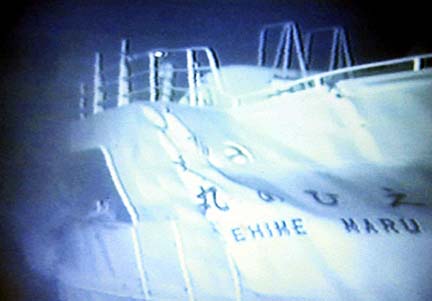


UH researcher urges The Ehime Maru could continue to contribute to fisheries knowledge after a recovery operation if the Japanese government and other concerned parties agree.
fisheries role
for Ehime Maru
The ship could serve as a needed
habitat for onaga and ehuBy Helen Altonn
haltonn@starbulletin.comNoting it "may be a little radical," Chris Kelley, University of Hawaii bottom-fish researcher, suggested the idea while discussing his program recently at the state Department of Land and Natural Resources.
"What if the DLNR could talk to the Navy and suggest the possibility of having the Ehime Maru continue its mission in fisheries research?" he asked.
The Japanese vessel, with 35 people aboard, was rammed Feb. 9 by the nuclear submarine USS Greeneville. Three crewmen, four students and two teachers of Uwajima Fisheries High School were not found.
Preparations are under way to move the ship to a shallow recovery site near the Honolulu Airport reef runway late this month. A $40 million recovery operation is expected to begin next month. Divers will try to recover bodies of those missing, personal effects and certain items from the ship.
After divers remove diesel oil and other lubricants, it is planned to move the Ehime Maru back to a deep-water site.
Instead, Kelley suggests moving it to a restricted fishing reserve about 10 miles from the reef runway in Ewa Beach, saying, "We could turn this tragedy into something useful."
The vessel could be placed in 800- to 1,000-foot-deep water in the reserve, protected from fishing and deep enough that no one could disturb it, Kelley said.
He said one submersible dive a year could be devoted to monitoring the ship, bottom fish and other animals that typically inhabit that type of sea bottom.
If families were willing to allow the researchers to look at the ship periodically by submersible and were interested, he said they could provide them with some film footage.
With a large structure such as the Ehime Maru, Kelley said, "It could do some good for fisheries in Hawaii." There is little habitat in the Ewa Beach reserve for onaga and ehu, he said.
"It is mostly sand bottom and sand slope. If there was a way we could increase the amount of habitat in that reserve, we have the possibility of some fish sticking around, establishing residence and reseeding open areas.
"That's the whole concept of creating reserves -- not just to protect fish, but to protect a group of breeders to continue to reproduce and restock open fishing areas."
Gov. Ben Cayetano, asked about the suggestion, said he would not pursue it because it would be insensitive.
The Japanese Consulate General did not respond to a query about it.
William Devick, Aquatic Resources Division administrator, said: "In terms of concept, it is a great idea. I don't know if the Japanese would like it. The key issue is sensitivity."
Devick also pointed out that permit problems would have to be resolved.